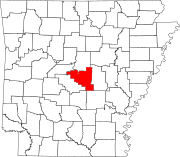Scott, Arkansas
Scott is an unincorporated community and census-designated place (CDP) in Lonoke and Pulaski counties in the central part of the U.S. state of Arkansas.
More than 1,000 years ago, a complex formation of mounds was created near what is now called Mound Pond by what is today known as the Plum Bayou culture,[4] a Pre-Columbian Native American culture that lived in what is now east-central Arkansas from 650–1050 CE, a time known as the Late Woodland Period.
Peter L. Lefevre and family were among the very first French settlers, locating in the fall of 1818 on the north side of the river on Spanish Grant No.
Chester Ashley was one of the first investors to acquire land in the area for plantation purposes in the early 1800s.
The duel was fought between John S. Marmaduke and Lucius M. Walker, two generals in the Confederate States Army.
A series of notes passed between the two generals by friends resulted in a duel, during which Marmaduke fatally wounded Walker.
The Union cavalry forced the Confederates to retreat which opened the route to the east of the river, leading to the Battle of Bayou Fourche on September 10, 1863, and the capture of Little Rock by the Union Army of Arkansas under the command of Major General Frederick Steele.
The St. Louis Southwestern Railway (known as the Cotton Belt Route) was constructed through the Scott area in 1871.
In 1912, Conoway Scott Jr. built a large brick building, intending to house a general store.
[18] The Arkansas Department of Parks Heritage & Tourism operates two facilities in the Scott area, one on the Pulaski County side and the other on the Lonoke County side, each with a focus on local history: Additionally, the history of Scott can be found at other sites around the community.
Charles Newton Alexander Sr., prominent planter, industrialist, and banker built Longbridge in 1906 as the centerpiece of his sprawling postbellum Plantation.
Alexander, born November 15, 1858, in Asheville NC, moved to Pulaski County in In 1879 at 21 years old.
He began farming upon arrival and added to his original holdings, until he became one of the largest and most influential land owners in central Arkansas.


